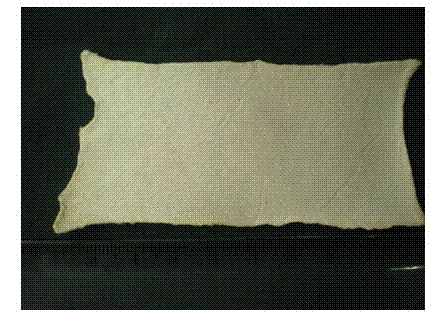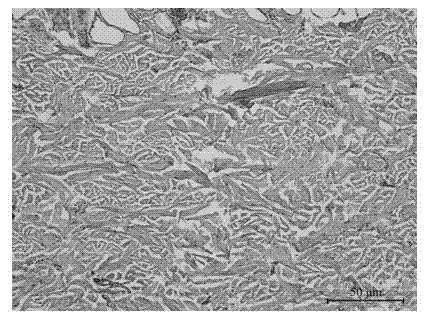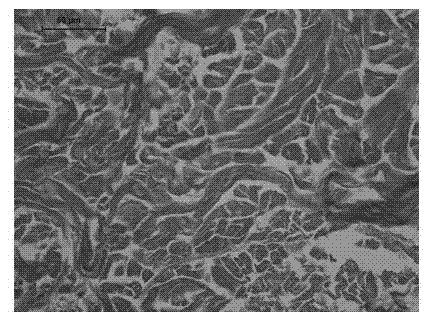Method for preparing acellular dermal matrix by utilizing ultrasonic wave
An acellular dermis and ultrasonic technology, applied in the field of medical skin tissue engineering, can solve the problems of long processing time, multi-chemical substances, complicated preparation process, etc., and achieve the effects of simple and practical preparation process, short production cycle and environmental friendliness
- Summary
- Abstract
- Description
- Claims
- Application Information
AI Technical Summary
Problems solved by technology
Method used
Image
Examples
Embodiment 1
[0039] Example 1. Preparation of heterogeneous acellular dermal matrix
[0040] (1) Peel off the healthy newborn cow skin and shave off the hair;
[0041] (2) Wash and soak with 0.1% benzalkonium bromide solution, sterilize the skin with povidone iodine for 5 minutes, and use a skin drum to take the reticular dermis with a thickness of 0.2 mm under aseptic conditions;
[0042] (3) Shock the reticular dermis in distilled water for 2 hours, then place it in 1 M NaCl for 2 hours;
[0043] (4) Repeat step (3) 3 times;
[0044](5) Put the reticulated dermis in 0.5% Triton X-100 and treat it with an ultrasonic cleaner for 24 hours. The frequency of the ultrasonic cleaner is set to 40 kHz and the power is 250 W;
[0045] (6) Wash 3 times with sterile phosphate buffered saline, 15 min each time, and sterilize with ethylene oxide to obtain the acellular dermal matrix.
Embodiment 2
[0046] Example 2, preparation of heterogeneous acellular dermal matrix
[0047] (1) Peel off the skin of healthy and clean SD rats, and shave off the hair;
[0048] (2) Wash and soak with 0.1% benzalkonium bromide solution, sterilize the skin with povidone iodine for 5 minutes, and use a skin drum to take the reticular dermis with a thickness of 0.3 mm under aseptic conditions;
[0049] (3) Shock the reticular dermis in distilled water for 1 hour, then place it in 1 M NaCl for 1 hour;
[0050] (4) Repeat step (3) 3 times;
[0051] (5) Treat the reticular dermis in 0.5% Triton X-100 with an ultrasonic cleaner for 12 hours, set the frequency to 40 kHz, and power to 250 W;
[0052] (6) Wash 3 times with sterile phosphate buffered saline, 15 min each time, and sterilize with ethylene oxide to obtain the acellular dermal matrix.
Embodiment 3
[0053] Example 3, preparation of heterogeneous acellular dermal matrix
[0054] (1) Peel off the healthy rabbit skin and shave off the hair;
[0055] (2) Wash and soak with 0.1% benzalkonium bromide solution, sterilize the skin with 75% alcohol for 5 minutes, and use a skin drum to take the reticular dermis with a thickness of 0.3 mm under aseptic conditions;
[0056] (3) Place the reticular dermis in a mixture of 10 mM Trizma HCl and 10 mM EDTA for 2 hours, and then place it in 1 M NaCl for 2 hours;
[0057] (4) Repeat step (3) 3 times;
[0058] (5) Put the reticulated dermis in 0.5% Tween-20 and treat it with an ultrasonic cleaner for 20 hours. The frequency of the ultrasonic cleaner is set to 30 kHz and the power is 250 W;
[0059] (6) Wash 3 times with sterile phosphate buffered saline, 15 min each time, and sterilize with ethylene oxide to obtain the acellular dermal matrix.
PUM
| Property | Measurement | Unit |
|---|---|---|
| Thickness | aaaaa | aaaaa |
Abstract
Description
Claims
Application Information
 Login to View More
Login to View More - R&D
- Intellectual Property
- Life Sciences
- Materials
- Tech Scout
- Unparalleled Data Quality
- Higher Quality Content
- 60% Fewer Hallucinations
Browse by: Latest US Patents, China's latest patents, Technical Efficacy Thesaurus, Application Domain, Technology Topic, Popular Technical Reports.
© 2025 PatSnap. All rights reserved.Legal|Privacy policy|Modern Slavery Act Transparency Statement|Sitemap|About US| Contact US: help@patsnap.com



